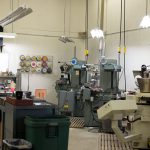 Do you want to hire professional metal stamping services?
Do you want to hire professional metal stamping services?
Having more knowledge about stamped metal will make it easier for you to choose the right company.
Modern stamped metal is used for a wide range of applications, and if you need stamped metal parts, you should know what you’re paying for. You’ll learn all you need to know about the industry in this guide. Take a look so you can hire the best company!
History of Metal Stamping
In the 1880s, the first stamped metal parts were widely used in the production of bicycles. Die forging and machining were replaced by stamping, allowing parts to be made for much less money.
Stamped metal parts are not quite as strong as die forged metal, but they’re good enough for most tasks.
Those stamped bicycle parts were imported to the U.S. from Germany by 1890. As a result, some U.S. machine tool companies began making their own custom stamping machines.
The bicycle was followed by the automobile, of course. Several automakers used stamped components for their vehicles long before Ford Motor Company popularized assembly line manufacturing.
Ford’s engineers actually recommended using stamped metal, but Ford didn’t listen to them at the time. However, it soon became evident that die-forged metal parts would not be able to satisfy customer demand, so stamped metal was introduced.
Stamped Metal Today
Today, stamped metal parts permeate many facets of our daily lives. In general, household appliances such as washing machines and dryers are made from stamped sheet metal.
Metal stamping is used to produce everyday items like silverware that we eat with and pots and pans that we use to cook. We still use stamped metal parts in our cars.
Stamped metal is also used in cigarette lighters, aluminum drink cans, gun shells, and some solid gold jewelry. It’s even found in computers and smartphones. The world around us is full of stamped metal.
Perceptions of Metal Stamping
Despite the importance of stamped metal, not everyone views the people who make it the same way.
Some people think metal stamping is an unskilled, dirty factory job. To get the job done, these craftspeople must be skilled artisans with extensive knowledge.
An extensive list of tasks goes into stamping metal parts. A diemaker must design and make the die, troubleshoot issues as they arise, and perform maintenance on the machines and parts involved.
While metal stampers are hands-on, they need to be creative, intelligent problem solvers. While new technology has taken over some of the manual labor, brainpower has become an even more important part of metal stamping. Developing these parts would be impossible without the right people.
Metal stampers often strive for perfection in their craft and become masters of their trade. To function well, stamped metal pieces need to fit perfectly. Fit and function are essential for stamped metal parts.
Some parts of the die need to be very precise, accurate in order to function correctly. It takes a good metal stamper time to make these parts precisely while knowing which parts can be manufactured more quickly.
Appearance Doesn’t Always Matter
There are many steps in the metal stamping process where appearance is not important. The finished product must look great, but the die and tools must only look good enough to function.
Even if stamping metal companies don’t have flawless tools or a pristine workspace, don’t worry – they’re probably focusing on the more important aspects of their business. Performance is more important than aesthetics.
Stamped Metalwork is Science, Not Art
Creating stamped metal is thought to be an art form. Despite the need for creative problem-solving skills, the job is not artistic in nature. Stamped metal is a more scientific process.
Metalworkers who are the best are creative, but they use practical experience and a set of professional skills to build things that function. For parts to perform well, it is necessary to have a solid understanding of physics.
The training and education required for a career in metalworking are extensive. The majority of this education is done on-the-job, but some of it is more traditional. Having a combination of academic and real-life knowledge can be helpful.
Because the industry leaves little room for error, diemakers must do their jobs well. In order for things to come out right every time, scientific knowledge is required.
The Metal Stamping Process
It is possible to use a variety of tools and machines to make stamped metal, but three things are essential: the sheet metal for the part, the stamping die, and the stamping press.
Throughout the entire process, the goal is to get the sheet metal the right shape and size for its intended use. In some cases, hot stamping is used, but in most cases, cold forming is used. The operation does not involve any additional heat.
Even though the process of cold forming generates heat, it is still a natural process. Heat is created when the metal is cut and formed by friction with the die. In other words, the metal coming out of the dies is usually very hot.
Do You Need Stamped Metal Parts?
Many industries require stamped metal components.
Choosing a professional metal stamping company is important if you need them for your business. A poorly constructed part may not even work if you do not follow this guide.





